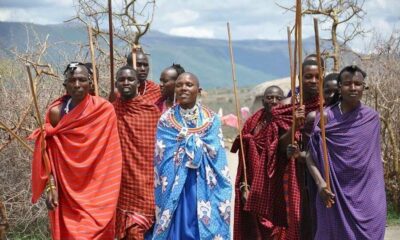President Samia Suluhu Hassan aims to increase the portion of Tanzanian land designated for conservation from 30% to 50% of the nation’s total area. However, these efforts are negatively impacting the indigenous Maasai communities.
The new conservation regulations prohibit human settlements and the construction of buildings, schools, and hospitals in protected zones. The sole exception is for tourism facilities, leading to the decline of existing government infrastructure in these regions, as noted by Joseph Oleshangay, a Maasai leader in Ngorongoro and a legal representative for the community in various legal disputes.
Tanzania aims to draw significant foreign investment and increase tourism by enlarging its protected areas. Tanzania’s nature reserves welcomed more than a million visitors last year. China has injected over $9 million (€8.3 million) into a geopark located in the Ngorongoro Conservation Area, named after the Ngorongoro Crater. The region is enclosed to safeguard tourist facilities, upscale accommodations, and scenic viewing spots. The Maasai people, who have ancestral connections to the area, are currently prohibited from entering.
The UAE has invested over $7 billion in Tanzania, including a hunting ground in Loliondo. Luxury lodges and a private plane airstrip are under construction to cater to affluent sheikhs coming to hunt big game. This region, typically used for grazing Maasai cattle in the dry season, is now being enclosed.
By expanding its preserved lands, Tanzania hopes to attract billions in foreign investment as well as more tourists. Last year, more than a million people visited Tanzania’s protected nature parks.
China, for instance, invested more than $9 million (€8.3 million) in a geopark in the Ngorongoro Conservation Area, named after the Ngorongoro Crater. The area was fenced in to protect tourist camps, luxury hotels and picnic areas with panoramic viewing platforms. The Maasai, whose ancestors used to live on the land, are now denied entry.
The United Arab Emirates (UAE) has also invested more than $7 billion in Tanzania. Among their investments, is a hunting ground in Loliondo. Luxury lodges and an airstrip for private planes are being built to welcome wealthy sheikhs flying in to hunt big game. This area, too, is being fenced in, even though it is a traditional grazing area for Maasai cattle herds during the dry season.
Tanzania’s parliament is currently debating another proposal, which DW has seen, for the creation of still more protected areas. These plans, while aimed at boosting the country’s tourism industry and foreign investment, are displacing the Maasai and other indigenous communities, raising concerns about the impact on their livelihoods and cultural heritage. The debate over conservation versus community rights is intensifying as Tanzania navigates its ambitious goals for economic development and environmental preservation.
The expansion of Tanzania’s protected lands is part of a broader strategy to increase foreign investment and tourism revenues. Last year, the country welcomed over a million visitors to its nature parks, generating significant income. China, for example, invested more than $9 million in a geopark within the Ngorongoro Conservation Area. This project involved fencing off the area to protect tourist camps, luxury hotels, and picnic sites, excluding the Maasai from their ancestral lands.
The UAE has invested over $7 billion in various Tanzanian projects, including a hunting ground in Loliondo. Luxury lodges and an airstrip for private planes are under construction to accommodate wealthy sheikhs seeking big game hunting experiences. This development has also resulted in the fencing of traditional Maasai grazing lands.
Tanzania’s parliament is currently debating additional proposals for creating more protected areas. These proposals, while intended to enhance tourism and attract foreign investment, have sparked controversy due to their impact on indigenous communities. The Maasai and other groups face displacement and restrictions on their traditional ways of life. As Tanzania pursues its ambitious economic and environmental goals, the tension between conservation efforts and the rights of local communities continues to escalate.
